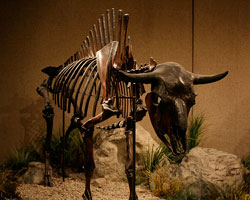Bison Bone Study
Archaeologists have long used animal bones to answer questions about human use of animals over time. The bones can indicate the presence of particular animals, the season in which they were hunted, the age and sex of the animals, and how they were butchered and discarded. Now there are ways to study the chemistry of the bones, in order to reconstruct past environmental conditions or the past diet of animals.
Tamara Varney, a graduate student at the University of Calgary, is currently undertaking a stable carbon isotopic analysis of bison bones from Waterton Lakes and Banff National Parks. The bone samples date within the past 3000 years, and represent about 28 individual bison from a number of sites. By applying new techniques to this collection of bones, researchers can address questions that have arisen since the bones were originally recovered. The main purpose of this analysis is to discover whether there were resident bison populations in the foothills and mountain valleys, or whether bison herds were more migratory and used the foothills and valleys only as wintering areas.
 Analysis of 16 samples representing sites in Waterton indicate that the bison migrated. The diet of 14 of the bison tested included about 10 to 23% arid grasses. These bison must have fed in the drier mixed prairie to the south and east of the park for at least part of their lives. None of the samples had the values expected if the animals had been residents of those dry grasslands. Two individuals had very low consumption of dry grasses, suggesting they were either residents of the park or moved mainly through this area. Samples taken from the Entrance Site in Waterton Lakes(a major archaeological winter campsite where there were large excavations in the early 1970's) indicated that these bison also obtained a big part of their diet from drier grasslands.
Analysis of 16 samples representing sites in Waterton indicate that the bison migrated. The diet of 14 of the bison tested included about 10 to 23% arid grasses. These bison must have fed in the drier mixed prairie to the south and east of the park for at least part of their lives. None of the samples had the values expected if the animals had been residents of those dry grasslands. Two individuals had very low consumption of dry grasses, suggesting they were either residents of the park or moved mainly through this area. Samples taken from the Entrance Site in Waterton Lakes(a major archaeological winter campsite where there were large excavations in the early 1970's) indicated that these bison also obtained a big part of their diet from drier grasslands.
There have been few isotopic studies of bison bone from mountain and foothill sites, but the Waterton results are comparable to those of a study that included bone from southern Alberta, southern Saskatchewan, and the Peace River. That study determined that bison moved from the mixed prairie into the parkland, a conclusion supported by historical and ecological studies of seasonal bison migration.
While results from these bones can imply that bison migrated between the drier grasslands and the mountains. the results can't determine the precise seasons in which the bison used each vegetation community. A more complete study of the bones could contribute useful information in this regard. The next step could be to obtain "control" data from contemporary bison that lived their entire lives in the Waterton bison paddock. The results from these samples would represent a known diet.
We do not yet understand the past ecology of bison well enough to determine what their role in ecosystem restoration should be. Using archaeological samples to examine a free-ranging bison population as it was before their near extinction provides a useful perspective on this issue.